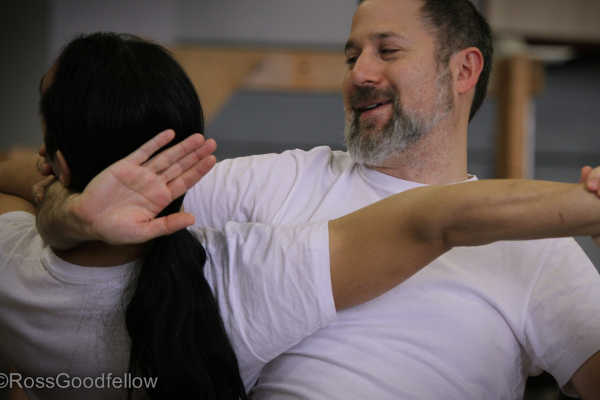Grappling (abrazare) 
There is no better manner than using the world's oldest fighting style - grappling [1] or abrazare to convey the concepts of timing and distance. Grappling is a form of wrestling, which is inarguably, the world's oldest fighting style, where grapplers were depicted on Egyptian wall paintings as far back as 5,000 years ago. However, the Greeks were the ones who put wrestling on the map of the ancient world, making its Olympic [2] debut in 708 BC.
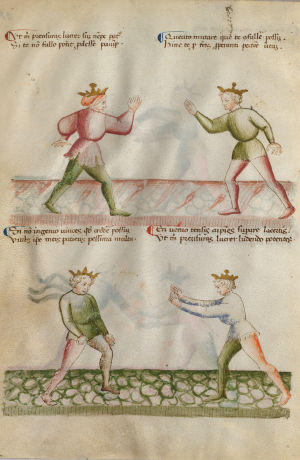
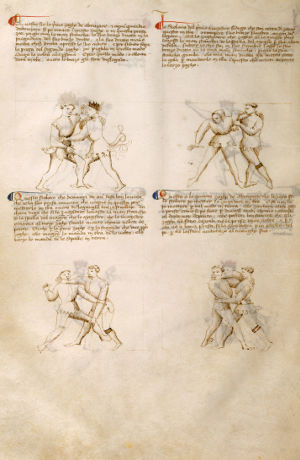
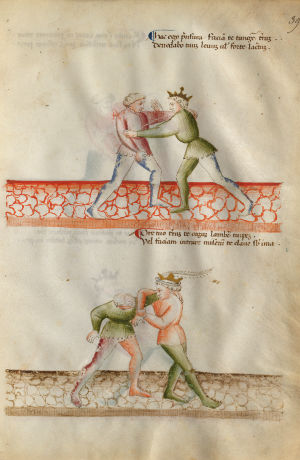
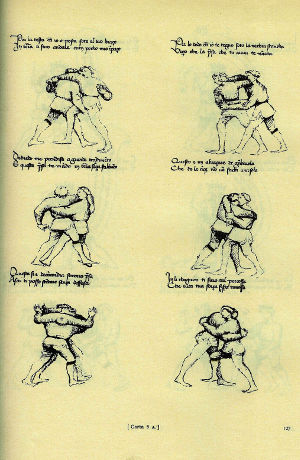
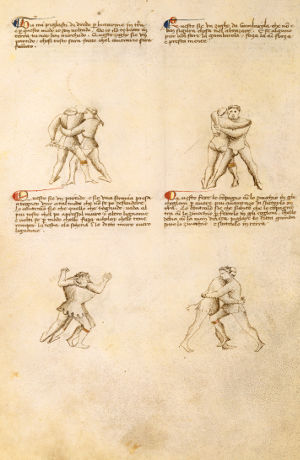
Grappling training begins with a number of contemporary wrestling techniques such as a shoulder hold, neck hold, waist hold, head locks and techniques for breaking out of these holds. This approach offers a simple introduction to some of the fundamental basics of grappling and provides the opportunity for students to become more comfortable with "man-handling" their training partners and to also increase their comfort with being "man-handled" themselves. These introductory practices also helps to develop a degree of trust with their training partners so that when the more sophisticated Fiore techniques are rolled into training, the students are well conditioned to learn and practice new techniques with their training partners with a higher degree of personal safety. These skills that are learned form the foundation on which other skills are layered upon, such as dagger and longsword techniques. The student is then introduced to techniques described in Liberi's treatise. It is critical that the student comprehend that the techniques learned during grappling training and the later dagger training, are extremely dangerous techniques! The student must remain cognizant that his/her partner is exactly that, a training partner, and not someone to compete with during the training exercises. In Liberi's manuscript, there are actually very few instances (four instances) in which he refers to the partner as an opponent. The student views his/her training partner in the light of a player (a zugadore (Italian), a partner in training) or companion (a compagno (Italian), another reference to a partner in a non-aggressive orientation).
The student at the end of the grappling portion of training will have developed a good understanding and a skills base in the area of guards (positions in preparation to deploy defensive or offensive maneuvers) and begin to develop the concept of timing, distance, judgment and position and their application to fighting. Advanced grappling and throw techniques described in "plays" by Fiore will be explored in detail during training.
- Grappling refers to techniques, maneuvers, and counters applied to an opponent in order to gain a physical advantage in hand-to-hand combat, such as improving relative position, escaping, submitting, or injury to the opponent. Grappling is a general term that covers techniques used in many disciplines, styles and martial arts that are practiced both as combat sports and for self-defense. Grappling most commonly does not include striking or the use of weapons. However, some fighting styles or martial arts known especially for their grappling techniques teach tactics that include strikes and weapons either alongside grappling or combined with it. source: Wikipedia. Grappling. Retrieved: January 17, 2017.
- The most widely accepted inception date for the Ancient Olympics is 776 BC ("Olympic Games". Encyclopædia Britannica. Retrieved January 17, 2017); this is based on inscriptions, found at Olympia, listing the winners of a footrace held every four years starting in 776 BC. The Ancient Games featured running events, a pentathlon (consisting of a jumping event, discus and javelin throws, a foot race, and wrestling), boxing, wrestling, pankration, and equestrian events. Tradition has it that Coroebus, a cook from the city of Elis, was the first Olympic champion. source: Wikipedia. Olympic Games. Retrieved: January 17, 2017.

